Widely known story about Kaunas pogrom and mistakenly named „Lietūkis garage“ episode needs a careful and facts-based approach in order to restore the real story behind these war crimes. The pogrom took place just after June Uprising, when Lithuanian military units took over control in the inter-war capital city Kaunas a few days before German army reached it.
German army took an active and leading role in the organization of Kaunas pogrom. Franz Walter Stahlecker, Head of Einsatzgruppe A., (source – Nbg Dok. 180-L) described the strategy of German army:
Similarly, within a few hours of our entering the city, local anti-Semitic elements were induced to engage in pogroms against the Jews, despite the extremely difficult conditions. [..] It was thought a good idea for the security police not to be seen to be involved, at least not immediately, in these unusually tough measures, which were also bound to attract attention in German circles. The impression had to be created that the local population itself had taken the first steps of its own accord as a natural reaction to decades of oppression by the Jews and the more recent terror exerted by the Communists.
At the same time Soviet regime tried to further falsificate the history and remove all facts, linking the pogrom to the atrocities (especially – June deportations, when thousands of Lithuanians were killed and deportated to Siberia) carried on by Soviets just a few weeks earlier. Therefore Soviets-related facts are usually missing and forgotten, whereas they are an important and essential part of general picture.
Public massacre of 50+ humans
 Extraordinary cruel killing of jews in Kaunas was recorder in the protocol of semi-puppet Lithuanian government (officially – Provisional Government of Lithuania or Lietuvos laikinoji Vyriausybė) on June 27th, 1941.
Extraordinary cruel killing of jews in Kaunas was recorder in the protocol of semi-puppet Lithuanian government (officially – Provisional Government of Lithuania or Lietuvos laikinoji Vyriausybė) on June 27th, 1941.
Minister of Utilities Vytautas Žemkalnis-Landsbergis reported about extraordinary cruel killing of jews in Kaunas, yard of former „Lietūkis“ garage.
Ministers decided, that „[..] public jews execution should be avoided inspite all measures required to be taken against jews for their communist activity and harm for the German army, partisans and particular citizens. It was noted, that killing was carried by people, which have no ties with Lithuanian Activist Front, Partisan Headquarters or Provisional Government of Lithuania“.
Date & time
The eyewitnesses reports do not provide a clear answer about the date of garage event.
For example, the colonel of German army states that it took place on 27th June (the day he arrived in Kaunas). The photographer states that it took place on Wedenesday, 25th June (the day he arrived in Kaunas with an advance party). The lance-corporal in 562nd Baker’s Company states that the incident took place on 23rd June (the day he arrived in Kaunas with his company). The sergeant-major from 562nd Baker’s Company states that the incident took place on the day after his arrival in Kaunas, which was two or three days after the town was taken by the Germans (that implies a date of 28 June at the earliest).
It is clear, that reports are contradictory and two main versions should be taken into account – 25th (Wednesday) or 27th (Friday) of June, 1941.
Place
The usual name associated to the place is „Lietūkis“ garage, which is not true. It would have been correct in inter-war period, but after Soviet occupation the garage and yard was controled by NKVD (Народный комиссариат внутренних дел) – Soviet security unit, closely associated with the Soviet secret police which at times was part of the agency and is known for its political repression.
The real name of the institution in charge of the garage changes a lot in understanding of the event and circumstances. Aleksandras Bendinskas, one of the organizers of June Uprising and member of Lithuanian Activist Front staff, reports:
[..] But already on the evening of June 22 in the general commotion the Bolsheviks began to flee en masse. But not everyone fled on the first day. Some top security, police, Party and government officials remained to destroy documents which testified to their crimes and their scope, the lists of their agents, the direct involvement of Moscow in provocations of that time. Among these zealous ones were Russians, Lithuanians, and Jews. Toward evening on June 23, security personnel (the majority of whom were investigators) also decided to save themselves. They ran to the Lietukis garage for cars. They were caught by one of the “fives”, disarmed and locked up in the garage, since the prison and security departments were not yet fully in our hands. Furthermore, street battles were going on. In some plants and institutions the security departments were broken into and lists were used to find out the names of their heads. Some of these were caught and they also were put into the garage. On June 25, some political prisoners liberated from Soviet jails found out that security personnel were being held in the garage. They came to check this out and recognized some of them. There began something which no one could have foreseen in advance: filled with malice, their backs bloody, driven by revenge, with broken fingers, some had lost their families carried off in train cars to Siberia, the former prisoners killed those held in the garage. They beat them with whatever they found in the garage – with metal bars, with spades, etc.
Series of photographs
The event photo series was made by a German army photographer Wilhelm Gunsilius, who had a special authorisation from 16th Army High Command to take photographs everywhere.
NB! In order to view the picture in full resolution available – right-click and choose View picture.
View from the fence
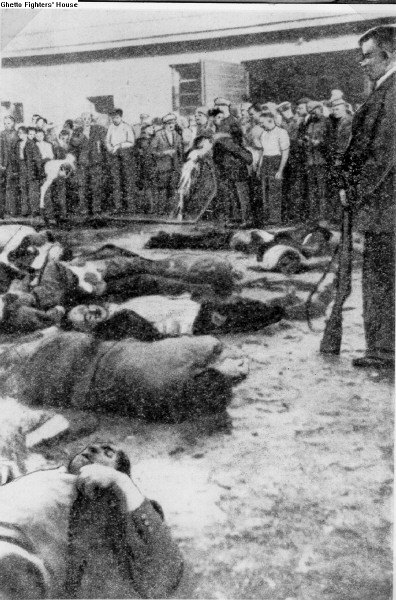


Note the roof of the car – it is similar to view from the garage – the photo most probably taken from the fence
Timeline remarks:
- no crowd
- only soldiers
- civilian-look crowd
View from the garage – watering
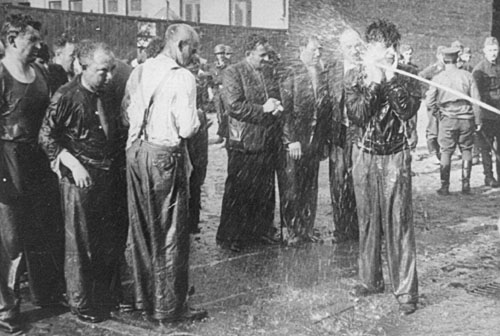

Initial phase – no crowd beside the fence.
Two separate groups of people watered.
Note the same car seen from the fence photo.
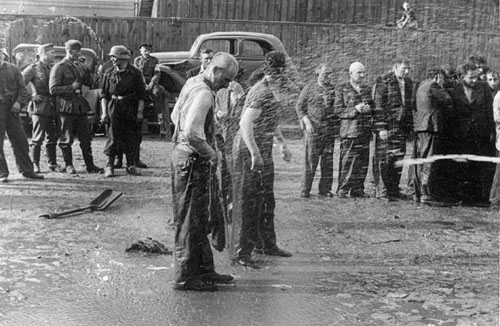
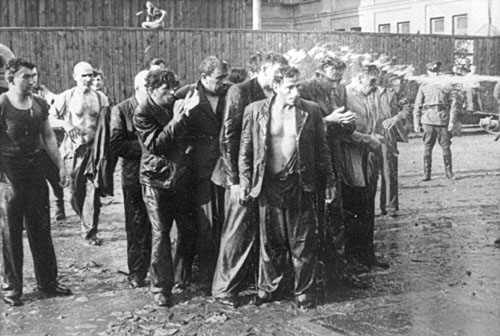

View from the garage – beating with rods

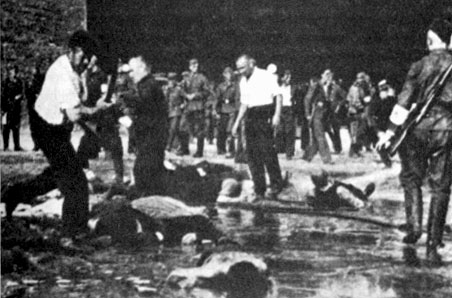

Note the change of crowd members and contingent.
Timeline remarks:
- several people
- soldiers
- civilian-look crowd


„The Death dealer“
Several account relate majority of killings to this man.

Aftermath
Unidentifiable human corpses.
Timeline reconstruction
Starting with no crowd, people taken in groups of ~10 and are beaten to death. The total number of people killed (on the ground) ~30 + one extra group.
The event started as closed activity, then 10-15 soldiers in uniform join as watchers. The final stage is accompanied by a huge crowd of 60-80 persons.
The photographer was allowed to make close shots.
Identified victims
According to Eliezer Zilber, data from Lithuanian Central State Archive department in Kaunas helped to identify these victims (their occupation and links to Soviet regime attrocities remain without confirmation):
- No-chum Paulin
- George Shtrom
- Itzok Grin
- Shloime Goldstein
- Chaim Zilber
- Aron Akab
- Shmerl Finn
- Lipe Segal
- Motle Sandle
 n PR industry, especially during communication audit, when situation SWOT is being produced. Skeleton might be a real yet undisclosed weakness or potentially dangerous outcome (threat) of some major forces. In both ways the information would start the process, which could evolve into a substantial crisis situation.
n PR industry, especially during communication audit, when situation SWOT is being produced. Skeleton might be a real yet undisclosed weakness or potentially dangerous outcome (threat) of some major forces. In both ways the information would start the process, which could evolve into a substantial crisis situation.














